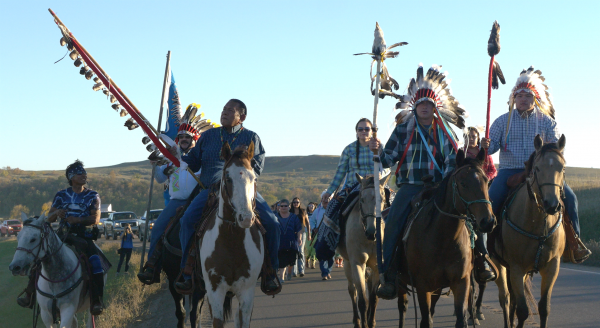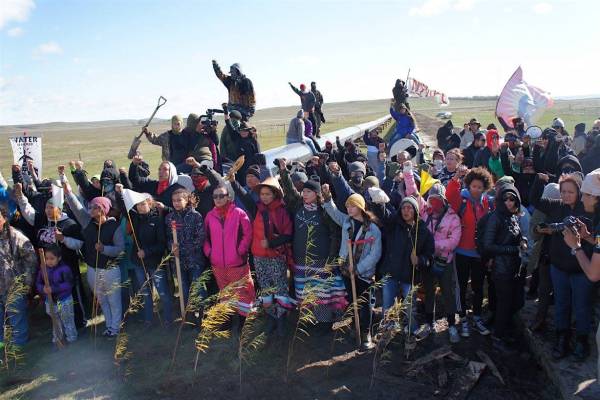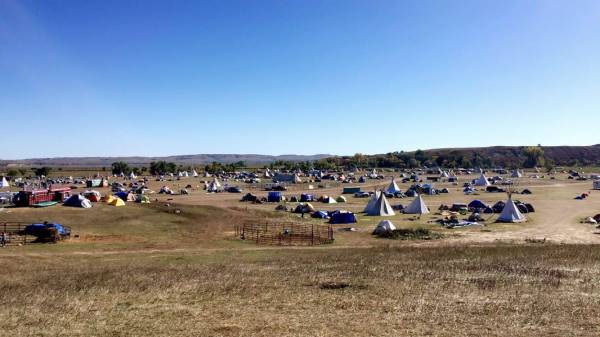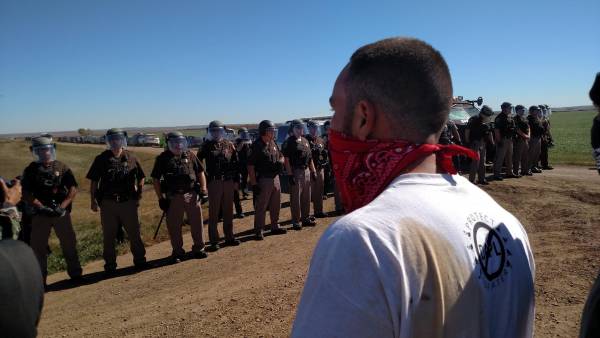In Cannon Ball, North Dakota, thousands of Indigenous people and their allies have gathered since April to stand in solidarity with the Standing Rock Sioux Nation against the Dakota Access Pipeline. This week, I had the opportunity to go to the Sacred Stone Spirit camp with some of my 350.org team members.
As soon as the first light hits, the camp is already alive with the sound of drums, morning announcements, and horses nickering. If you take a walk to the river – the Cannon Ball River, which sits alongside the camp and flows into the Missouri River seen off in the distance – you’ll find steam rising from the water into the cool morning air, horses drinking from the river and grazing on the tall grass, and witness people in morning prayer.
As morning continues, children head off to school (a school has been set up at the camp), the head cooks begin preparing meals while others help by chopping wood, building more tents, or making art. As the day continues, you’ll see a caravan of cars entering the camp signaling the arrival of another tribe that’s come to stand with Standing Rock, or see a caravan of cars leaving the camp to head out for a peaceful action along the pipeline route.

People from the Fort Peck tribe in Montana arrive to offer support and bring supplies. Photo by Jade Begay.
There are thousands of people at the camp now. The Sacred Stone Spirit Camp was the first – but as the camp has grown, it’s expanded five or ten fold. What began as an overflow camp since there was no more room at Sacred Stone, The Oceti Sakowin Camp – which means The Seven Council Fires – has become so big that it has its own kitchens, two solar charging stations, horse corrals, a school, medical tent, and more. Within Oceti Sakowin is the Red Warrior Camp, and across the river is the Rosebud Camp.
Life at the camp is deeply spiritual, healing and communal. Despite what you see in the news portraying violent protesters, that couldn’t be further from the truth. At camp, there are children running around and people working hard to keep the camp functioning by doing important duties like sorting donated supplies, delivering firewood and emptying dumpsters. There is no alcohol, drugs or weapons allowed at the camp. At night, people gather around the sacred fire and share stories, and welcome people from far and wide who’ve come to the camp.
For the people here, this is not just a fight to stop a pipeline. It is a prophecy coming true, a rebirth of historic traditions and culture, and a historic moment of unity for Tribal Nations across the country. This fight, which was started by tribal youth who ran on foot all the way to Washington D.C. to call attention to this pipeline, is about healing and restoring balance with Mother Earth. It’s about acting with the next seven generations in mind and making sure that what we do today will benefit, not harm them.
The indigenous people leading this movement have no plans of leaving – right now they’re preparing for the winter. There is no question – they know they will defeat the Dakota Access Pipeline through prayer, unity and by putting their bodies on the line.
The direct impact and ripple effects of this fight are momentous. The movement against this pipeline is not only starting a national conversation about how tribes are consulted about infrastructure projects that impact their lands in ways that honor their sovereignty and treaties, but also signaling the end of fossil fuels and the beginning of a just transition.
While those on the front lines are full of hope and prepared to do whatever it takes to stop this project – known as the Black Snake – it hasn’t been and will not be easy. Each day, a surveillance plane and helicopter circle the camp. The police drive by often and have set up a checkpoint on the road that leads to the camp. At the checkpoint, they ask questions and have even arrested some people for things as small as parking tickets.
At the non-violent direct actions that take place almost daily, even the most peaceful actions – such as one this week led by women and youth who planted willow trees and corn along the pipeline route – are met with a large police presence. At other actions, protectors have been met with over 30 riot cops with drawn weapons, armored patrol vehicles, and suspicious planes flying overhead. Meanwhile, helicopters circle above with many reporting cell phone signal outages at the action sites preventing people from being able to share live video or communicate with those outside the action.

Women and children plant willow trees and corn along the pipeline route. Photo: Indigenous Environmental Network
Despite all the challenges these water protectors face – militarized police, misleading media coverage, and a project that threatens everything they hold sacred – their strength and spirit is unstoppable. When I spoke with people at the camp, nearly everyone I met said that they have no plans to leave. They’ve put everything on hold to stand on the front lines of this fight – because it is a fight for their lives, for the future of indigenous rights, and for the sake of a livable planet.
I’ll never forget the image one morning as a group of protectors gathered on a hill to take a group photo. As a surveillance helicopter flew overhead, everyone spontaneously and instinctively raised their fists in the air and began singing in Lakota. In that moment, I felt how powerful and historic this moment is – and more sure than ever that this movement will defeat Dakota Access.

A surveillance helicopter flies overhead. Photo by: Hartman Deetz
As this battle continues, support and solidarity from all corners of the globe are paramount. Some of the ways allies can support those on the ground include:
- Go to Standing Rock to show your support and see what’s happening. Show up prepared to take care of yourself and to act as an ally. Here’s a list of 5 things to consider before going to Standing Rock.
- Donate to the legal funds, supply funds, or send donations.
- Sacred Stone Camp legal fund, supply fund and Amazon Wishlist
- Red Warrior Camp legal fund
- Call your local media and ask them to cover this historic moment of resistance and tribal unity.
- Organize a prayer or ceremony in honor of Standing Rock. This could be by your local water source, mountains, or sacred sites.
- Sign our petition to President Obama calling on him to stop the pipeline, once and for all.
- Share a message of solidarity with Standing Rock on this Tumblr page.
- Divest from the banks funding the pipeline and write a letter to your own bank if they’re on the list.
- Take on a fossil fuel fight in your community. It’s important to stand in solidarity with Standing Rock and it’s also important to honor their fight by standing up for your own water, air, climate and communities. Support Standing Rock by taking action to protect your own respective communities.
- Stay tuned for calls to action and opportunities to join or plan an action in your city.
I’m in awe and deeply grateful to those fighting on the front lines – which includes remarkable women warriors and youth – who are giving everything they have to this fight. You are brave and courageous – and we’re standing in solidarity with you.

The view of Oceti Sakowin camp from “Facebook Hill” where the cell signal is strongest. Photo by Emily Jovais

Photo by David Solnit

Hundreds of flags representing the tribes that are standing with Standing Rock line the road at camp. Photo: Emily Jovais